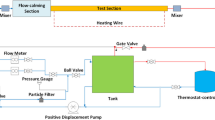Summary
We consider theoretically the problem of the shear rate in a cone-and-plate rheometer, giving particular attention to the effect of variable-viscosity behaviour on the departure of the predicted shear rate from that used in the conventional interpretation of experimental results. It is concluded that this departure is much greater for shear-thinning fluids than for Newtonian constant-viscosity fluids. It is also shown that edge effects are significantly enhanced by variable-viscosity behaviour. However, the predicted departure from the constant shear-rate normally assumed is still insignificant for gap angles usually employed in cone-and plate rheometers (≤ 4°).
Some consideration is also given toLodge's proposed method of normal-stress measurement which uses a truncated cone-and-plate assembly. It is concluded that the assumptions required to interpret the experimental results are valid to a sufficient degree of approximation. These assumptions concern the smooth transition from torsional flow to cone-and-plate flow near the abrupt change in geometry.
Finally, we discuss edge effects in the re-entrant cone situation suggested byCowsley. These are concluded to be significant, pointing to a serious source of experimental error.
Zusammenfassung
Das Problem der Schergeschwindigkeitsverteilung in einem Kegel-Platte-Rheometer wird theoretisch behandelt, wobei vor allem der Einfluß einer veränderlichen Viskosität auf die Abweichung der vorausgesagten Schergeschwindigkeit von dessen üblicherweise bei der Interpretation experimenteller Ergebnisse vorausgesetztem Verlauf untersucht wird. Man kommt zu dem Schluß, daß solche Abweichungen bei Flüssigkeiten mit Scherentzähung wesentlich stärker als bei newtonschen Flüssigkeiten sind. Ebenso wird gezeigt, daß die Randeffekte durch nicht-newtonsches Verhalten merklich vergrößert werden. Allerdings ist die vorausgesagte Abweichung von der in der Regel zugrundegelegten konstanten Schergeschwindigkeit dennoch vernachlässigbar, wenn die normalerweise bei Kegel-Platte-Rheometern benutzten Kegelwinkel (≤ 4°) Verwendung finden.
Weiterhin wird die vonLodge für Normalspannungsmessungen vorgeschlagene Methode betrachtet, bei der ein abgeschnittener Kegel benutzt wird. Man findet, daß die dabei gemachten Annahmen in hinreichender Näherung erfüllt sind. Diese Annahmen betreffen den stetigen Übergang von der Torsionsströmung zur Kegel-Platte-Strömung im Bereich der Geometrieänderung.
Endlich werden noch Randeffekte bei einem einspringenden Kegel untersucht, dessen Verwendung vonCowsley vorgeschlagen worden ist. Diese stellen sich als erheblich heraus, was auf eine ernsthafte Fehlerquelle bei der Auswertung der Experimente hinweist.
Similar content being viewed by others
References
Walters, K., Rheometry, Chapman and Hall (1975).
Leal, L. G., J. non-Newtonian Fluid Mechanics5, 33 (1979).
Williams, R. W., Rheol. Acta18, 345 (1979).
Griffin, D. S., R. S. Varga, J. Soc. Indust. Appl. Maths.11, 1046 (1963).
Varga, R. S., Matrix iterative analysis, Prentice Hall (1962).
Roache, P. J., Computational Fluid Dynamics, Hermosa Publishers (1972).
Paddon, D. J., Ph. D. thesis, University of Wales (1979).
Walters, K., N. D. Waters, Polymer Systems, Deformation and Flow, p. 211, Macmillan (1968).
Griffiths, D. F., K. Walters, J. Fluid Mech.42, 379 (1970).
Lodge, A. S., Rheol. Acta10, 554 (1971).
Jackson, R. A., A. Kaye, Brit. J. Appl. Phys.17, 1355 (1966).
Marsh, B. D., J. R. A. Pearson, Rheol. Acta7, 326 (1968).
Cowsley, C. W., Univ. of Cambridge, Dept. of Chemical Eng., Polymer Processing Res. Centre, Report No. 6.
Huilgol, R. R., Continuum Mechanics of Viscoelastic Liquids, J. Wiley and Sons (1975).
Author information
Authors and Affiliations
Additional information
With 26 figures
Rights and permissions
About this article
Cite this article
Paddon, D.J., Walters, K. On edge effects and related sources of error in rotational rheometry. Rheol Acta 18, 565–575 (1979). https://doi.org/10.1007/BF01520352
Received:
Issue Date:
DOI: https://doi.org/10.1007/BF01520352




